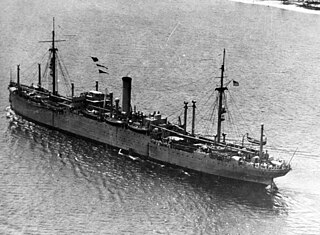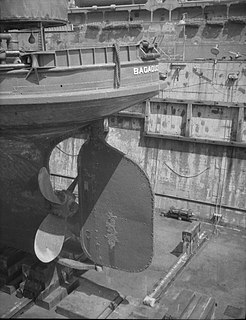USS Yuma has been the name of five ships of the United States Navy. The name is taken after the Yuma tribe of Arizona.

USS Algonquin, completed as El Toro in 1891 for the Southern Pacific Railroad's Morgan Line, was a small harbor tug commissioned by the United States Navy 2 April 1898. Renamed Accomac, after Accomac, Virginia, June 1898, renamed Nottoway in 1918 and, after the Navy adopted alphanumeric hull numbers on 17 July 1920, classified as YT-18, a district tug. On 5 October 1942 the name was cancelled and the tug was simply YT-18 until 1944 when classification was changed to YTL-18, a little harbor tug. Over the years as a Navy tug, from 1898 to 1946, the tug served from Cuba to Boston.
Six ships of the United States Navy have borne the name USS Powhatan or USNS Powhatan, named in honor of Powhatan (1550–1618), an Indian chief in tidewater Virginia; the father of Pocahontas.

USS Duplin (AKA-87) was a Tolland-class attack cargo ship of the United States Navy, in service from 1945 to 1946. She was sold into merchant service in 1946 and finally scrapped in 1971.

USS Woodcock (AM-14) was an Lapwing-class minesweeper acquired by the United States Navy for the dangerous task of removing mines from minefields laid in the water to prevent ships from passing.

USS Cahuilla (ATF-152) was an Abnaki class fleet tug in the service of the United States Navy during World War II. In 1961 she was sold to the Argentine Navy as ARA Irigoyen (A-1) where she served until 2009 when she became a Museum ship.
USS Carib (AT-82) was a Cherokee-class fleet tug constructed for the United States Navy during World War II. Her purpose was to aid ships, usually by towing, on the high seas or in combat or post-combat areas, plus "other duties as assigned." She served in the Atlantic Ocean and the Pacific Ocean.
USS ATA-176 was an ATR-1-class rescue tug built for the United States Navy during World War II. She was laid down on 30 January 1944 and launched on 1 March as USS ATR-103, but was re-designated ATA-176 on 15 May. She was commissioned as USS ATA-176 on 19 August. She served in the U.S. Pacific Fleet during the war and was decommissioned on 30 June 1947. She was then manned with a civilian crew and placed in service, being renamed USNS Tonkawa (T-ATA-176) on 16 July 1948. Tonkawa, the first U.S. Navy vessel named for the Tonkawa, was taken out of service in 1956 and placed in reserve.

USS Rappahannock (AF-6) was a Rappahannock-class stores ship acquired by the U.S. Navy for use in World War I. She served in the dangerous North Atlantic Ocean, delivering animals, such as horses and steers on-the-hoof, to American Expeditionary Force troops in Europe.

USS Gold Star (AK-12) was a U.S. Navy cargo ship that saw service before and during World War II. She was responsible for delivering necessary goods and equipment to ships and stations in the war zone.
USS Uncas has been the name of more than one United States Navy ship, and may refer to:

USS Bagaduce (AT-21/ATO-21) was the lead ship of the Bagaduce class of fleet tugs for the United States Navy. She was the first ship of the U.S. Navy of that name, and is named for the Bagaduce River and a peninsula in Hancock County, Maine.
USS Wandank has been the name of more than one United States Navy ship, and may refer to:

The first USS Wandank (AT-26), originally Fleet Tug No. 26, later ATO-26, was a United States Navy fleet tug in commission from 1920 to 1922 and again from 1922 to 1946.
USS Apache or USNS Apache has been the name of more than one United States Navy ship, and may refer to:
USS Geronimo may refer to:
The USS Pinola (AT–33) was a Bagaduce-class fleet tug, laid down on 3 March 1919 by Puget Sound Navy Yard in Bremerton, Washington, launched on the 12 August 1919, and was commissioned on 7 February 1920.
USS Cherokee (AT-66) was a US Navy fleet tug of the Navajo class, later renamed the Cherokee class. She was launched on 10 November 1939 by Bethlehem Shipbuilding Corp., Staten Island, New York and sponsored by Miss E. Mark; and commissioned 26 April 1940, Lieutenant Commander P. L. F. Weaver in command. Cherokee served during World War II in the North African campaign. She was redesignated ATF-66 on 15 May 1944.
USS Cusabo (ATF-155) was an Achomawi class fleet ocean tug built for the United States Navy during World War II. She was the only U.S. Naval vessel to bear the name.

The Type V ship is a United States Maritime Commission (MARCOM) designation for World War II tugboats. Type V was used in World War II, Korean War and the Vietnam War. Type V ships were used to move ships and barges. Type V tugboats were made of either steel or wood hulls. There were four types of tugboats ordered for World War II. The largest type V design was the sea worthy 186-foot (57 m) long steel hull, V4-M-A1. The V4-M-A1 design was used by a number of manufacturers; a total of 49 were built. A smaller steel hull tugboat was the 94-foot (29 m) V2-ME-A1; 26 were built. The largest wooden hull was the 148-foot (45 m) V3-S-AH2, of which 14 were built. The smaller wooden hull was the 58-foot (18 m) V2-M-AL1, which 35 were built. Most V2-M-AL1 tugboats were sent to England for the war efforts under the lend-lease act. The Type V tugs served across the globe during Work War II including: Pacific War, European theatre and in the United States. SS Farallon and other Type V tugs were used to help built Normandy ports, including Mulberry harbour, on D-Day, June 6, 1944 and made nine round trips to Normandy to deliver Phoenix breakwaters.
This page is based on this
Wikipedia article Text is available under the
CC BY-SA 4.0 license; additional terms may apply.
Images, videos and audio are available under their respective licenses.








